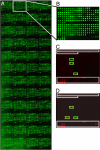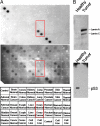Identification of differentially expressed proteins in ovarian cancer using high-density protein microarrays
- PMID: 17954908
- PMCID: PMC2077284
- DOI: 10.1073/pnas.0708572104
Identification of differentially expressed proteins in ovarian cancer using high-density protein microarrays
Abstract
Ovarian cancer is a leading cause of deaths, yet many aspects of the biology of the disease and a routine means of its detection are lacking. We have used protein microarrays and autoantibodies from cancer patients to identify proteins that are aberrantly expressed in ovarian tissue. Sera from 30 cancer patients and 30 healthy individuals were used to probe microarrays containing 5,005 human proteins. Ninety-four antigens were identified that exhibited enhanced reactivity from sera in cancer patients relative to control sera. The differential reactivity of four antigens was tested by using immunoblot analysis and tissue microarrays. Lamin A/C, SSRP1, and RALBP1 were found to exhibit increased expression in the cancer tissue relative to controls. The combined signals from multiple antigens proved to be a robust test to identify cancerous ovarian tissue. These antigens were also reactive with tissue from other types of cancer and thus are not specific to ovarian cancer. Overall our studies identified candidate tissue marker proteins for ovarian cancer and demonstrate that protein microarrays provide a powerful approach to identify proteins aberrantly expressed in disease states.
Conflict of interest statement
Conflict of interest statement: M.S. consults for Invitrogen Corporation and Affomix Corporation. M.H. currently works for Microbia Precision Engineering.
Figures






References
-
- Jemal A, Siegel R, Ward E, Murray T, Xu J, Smigal C, Thun M. CA Cancer J Clin. 2006;56:106–130. - PubMed
-
- Gatta G, Lasota M, Verdecchia A. Eur J Cancer. 1998;34:2218–2225. - PubMed
-
- Skates S, Horick N, Yu Y, Xu F, Berchuck A, Havrilesky L, de Bruijn H, van der Zee A, Woolas R, Jacobs I, et al. J Clin Oncol. 2004;22:4059–4066. - PubMed
-
- Bast R, Jr, Klug T, St John E, Jenison E, Niloff J, Lazarus H, Berkowitz R, Leavitt T, Griffiths C, Parker L, et al. N Engl J Med. 1983;309:883–887. - PubMed
-
- Wang H, Kachman M, Schwartz D, Cho K, Lubman D. Proteomics. 2004;4:2476–2495. - PubMed
Publication types
MeSH terms
Substances
LinkOut - more resources
Full Text Sources
Other Literature Sources
Medical
Miscellaneous

